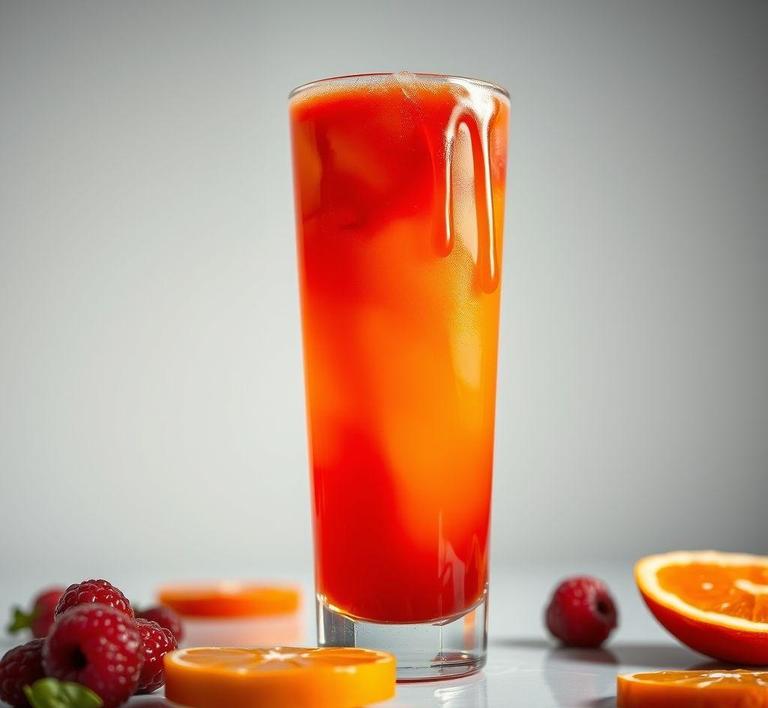If you’re looking to keep your juice concentrate fresh for a longer period of time, then the concept of refreezing juice concentrate is a game-changer. This guide walks you through the best practices for freezing and refreezing juice concentrate, ensuring you preserve its flavor, nutrients, and freshness. Whether you’re buying in bulk or simply want to store leftovers, learning the proper techniques for refreezing can help you avoid waste and make the most of your juice concentrate stash. From choosing the right containers to knowing how long you can safely store it, this guide has got you covered.
Can You Refreeze Juice Concentrate?

Refreezing juice concentrate is a question that often pops up, especially when you have leftover portions after thawing. The short answer: Yes, you can refreeze juice concentrate, but with some important caveats.
Juice concentrate, by its nature, is a highly concentrated form of fruit juice that has had much of its water removed, then frozen for preservation. When you thaw it, the concentrate returns to a liquid or semi-liquid state, often becoming more susceptible to microbial growth and texture changes if left at room temperature for too long.
Because refreezing involves thawing and then freezing again, it can compromise the quality and safety of the juice. Each thaw cycle gives microorganisms a chance to multiply (especially if the juice is not kept cold enough), and the repeated formation and melting of ice crystals can alter the texture, flavor, and nutritional value.
So, while refreezing is technically possible, it’s essential to understand how and when to do it safely to minimize quality degradation and food safety risks.
How To Refreeze Juice Concentrate?
If you decide to refreeze juice concentrate, here’s a detailed, step-by-step guide to doing it the right way:
-
Assess The State Of The Juice Concentrate
- If it has been thawed but kept refrigerated (below 40°F/4°C) and unused for less than 24 hours, it’s generally safe to refreeze.
- If the concentrate has been sitting out at room temperature for over 2 hours, discard it to avoid foodborne illness risks.
-
Use Airtight Containers
- Transfer the thawed juice concentrate into clean, airtight containers or freezer-safe bags. Remove as much air as possible to prevent freezer burn and oxidation, which can degrade flavor.
-
Label And Date
- Mark the container with the date of refreezing. Since refrozen concentrate may lose quality faster, it’s best to use it within 1 to 2 months for optimal taste.
-
Freeze Quickly
- Place the juice concentrate in the coldest part of your freezer (usually the back) to freeze it rapidly. Quick freezing helps reduce ice crystal size, which lessens texture damage.
-
Thaw Properly Next Time
- When you thaw refrozen juice concentrate, do so in the refrigerator, never at room temperature. Slow thawing keeps the juice safe and helps maintain flavor integrity.
Quality Impact
Refreezing juice concentrate does have a noticeable impact on quality, primarily due to these factors:
- Flavor Changes: The flavor profile of juice concentrate can shift slightly with each freeze-thaw cycle. The delicate balance of natural sugars, acids, and aromatic compounds can break down, leading to a duller or sometimes ‘off’ taste.
- Texture Alterations: Juice concentrate may become grainy or thicker due to ice crystal formation during freezing. Though it usually re-mixes well when stirred, repeated freezing may cause some separation or cloudiness.
- Nutrient Degradation: Vitamins like Vitamin C are sensitive to temperature changes. Each freeze-thaw cycle can lead to a reduction in these nutrients, diminishing the health benefits of the juice.
- Microbial Safety: While freezing halts microbial growth, thawing allows microbes to multiply if conditions are warm. Refreezing does not kill bacteria that have grown; it only stops further growth. Therefore, it’s crucial to minimize the time the concentrate spends thawed.
Overall, while the juice remains safe if handled properly, the sensory and nutritional qualities tend to decline with repeated freezing cycles.
you can refreeze juice concentrate, but it’s not ideal. The key to doing it safely lies in minimizing the thawed time, maintaining cold temperatures, and using proper airtight storage to reduce quality loss. Every freeze-thaw cycle impacts the juice’s flavor, texture, and nutritional value, so it’s best to only refreeze if absolutely necessary and consume it soon after.
If you frequently find yourself with leftover juice concentrate, consider portioning it into smaller containers before freezing initially – this way, you only thaw what you need, avoiding the need to refreeze altogether.
Is It Safe To Refreeze Juice Concentrate?
Refreezing juice concentrate is a question that often pops up in kitchens, especially after dealing with larger containers or unexpected leftovers. The short answer is: yes, it can be safe to refreeze juice concentrate, but with important caveats regarding the handling and state of the concentrate.
Juice concentrate is essentially fruit juice that has had the water removed, making it denser and more shelf-stable. This reduction in water content means it tends to freeze and thaw differently than regular juice. When frozen, the water crystallizes, but the sugars and acids remain more concentrated, often preserving flavor and texture better than standard juices.
The primary safety concern with refreezing juice concentrate relates to bacterial growth during thawing. Once the concentrate has thawed, any bacteria present can multiply, especially if the concentrate has been kept at unsafe temperatures (above 40°F or 4°C) for extended periods. Refreezing does not kill bacteria; it merely puts them into a dormant state. Therefore, if the juice was kept properly chilled and thawed only briefly, refreezing is generally safe.
From a quality perspective, repeated freeze-thaw cycles can degrade the flavor and texture. The natural sugars might crystallize unevenly, and the overall taste may become muted or altered. However, from a food safety standpoint, as long as proper hygiene and temperature controls are observed, refreezing juice concentrate is generally considered safe.
Signs That Juice Concentrate Should Not Be Refrozen
Knowing when to not refreeze juice concentrate is just as crucial as understanding when it’s safe to do so. Here are some key warning signs that your juice concentrate should be discarded rather than refrozen:
- Off or Sour Smell: If the juice smells fermented, sour, or “off”, it’s likely that bacterial or yeast growth has occurred during thawing. This is a clear indicator that the juice is no longer safe to consume or refreeze.
- Unusual Appearance: Cloudiness, sediment that wasn’t there before, or discoloration (such as dark spots or browning) may signal spoilage or oxidation.
- Froth or Bubbles: The presence of bubbles or froth that develops after thawing could indicate fermentation, a sign of microbial activity.
- Texture Changes: If the concentrate has separated into layers or has an unusually thick or gelatinous texture after thawing, it might be compromised.
- Long Time at Room Temperature: If the concentrate was left out at room temperature for more than two hours, bacteria may have multiplied to unsafe levels, making refreezing risky.
- Previous Multiple Freeze-Thaw Cycles: If the concentrate has already been refrozen and thawed several times, the risk of spoilage and microbial growth increases significantly.
If any of these signs are present, it’s best to err on the side of caution and avoid refreezing.
Common Refreezing Mistakes
Refreezing juice concentrate might sound straightforward, but there are several pitfalls that can degrade both safety and quality:
- Ignoring Temperature Guidelines: One of the most common errors is refreezing concentrate that was left out too long or stored at unsafe temperatures. This can promote bacterial growth that freezing will not eliminate.
- Refreezing Without Portioning: Refreezing an entire large container multiple times can cause repeated thawing and freezing cycles. Instead, dividing the concentrate into smaller portions before freezing helps maintain quality.
- Using Improper Containers: Using containers not designed for freezing, such as thin plastic or glass without headspace, can cause leaks, freezer burn, or breakage, affecting the juice’s taste and safety.
- Not Allowing Proper Thawing: Thawing juice concentrate at room temperature rather than in the refrigerator can allow bacterial growth and spoilage.
- Refreezing After Addition of Other Ingredients: Once juice concentrate is mixed with water or other ingredients, refreezing becomes more problematic due to altered texture and microbial risk.
Tips And Tricks
To make the most of your juice concentrate and safely refreeze when needed, consider these handy tips:
- Freeze in Small Portions: Use ice cube trays or small airtight containers to freeze concentrate in usable amounts. This minimizes waste and reduces refreezing cycles.
- Label Everything: Mark containers with dates and the number of freeze-thaw cycles to keep track of safety.
- Thaw in Refrigerator: Always thaw juice concentrate slowly in the fridge to keep it at safe temperatures and reduce spoilage risk.
- Avoid Refreezing More Than Once: Try to limit refreezing to a single cycle to preserve taste and safety.
- Use Freezer-Safe Containers: Choose containers that can expand (plastic or silicone) to prevent cracking and freezer burn.
- Keep It Airtight: Exposure to air can cause oxidation and off-flavors. Vacuum-sealed bags or tightly sealed containers work best.
- Check Before Refreezing: Smell and visually inspect the concentrate after thawing before deciding to refreeze it.
Conclusion
Refreezing juice concentrate is generally safe if done properly, with attention to temperature control, hygiene, and quality assessment. While repeated freeze-thaw cycles can degrade flavor and texture, the primary concern is ensuring the juice does not spend too long in unsafe temperature zones where bacteria can multiply. By understanding the signs of spoilage, avoiding common mistakes, and following practical tips, you can maximize the shelf life and safety of your juice concentrate without compromising its vibrant taste. When in doubt, always prioritize food safety and throw out any concentrate showing signs of spoilage.


